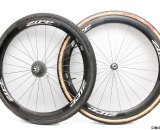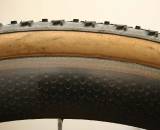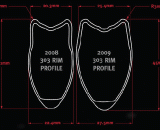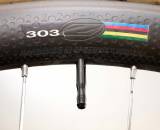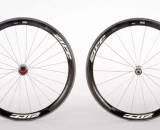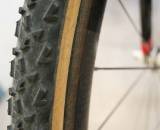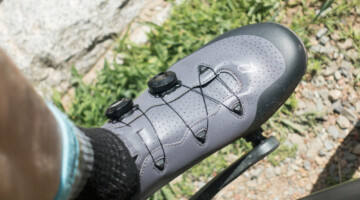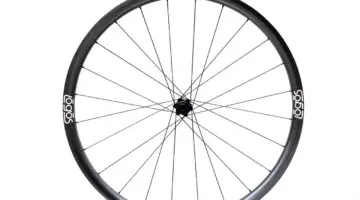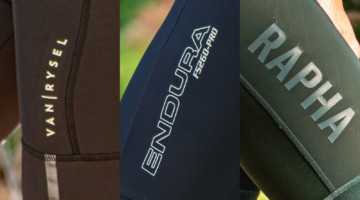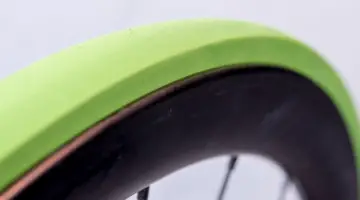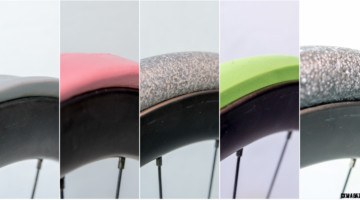Cyclocross Wheel Review: Zipp 303 Carbon Tubular Wheelset
Specs: 45mm deep carbon rim, silver Sapim CX-Ray aero stainless steel spokes with external nipples: 24 radial front, 24 rear, radial drive /1x non-drive. Campagnolo or Shimano freehub. 275-lb rider weight limit.
Weight: List: 1206g wheelset, 346g rim, 88g front hub, 188g rear hub. Measured: 1206g total, 554g front, 652g rear.
What comes in the box? Valve extenders, skewers.
MSRP: $2285
Tester(s): Clifford Lee, Andrew Yee
Spin-free test: Out of the box, the Indiana-made Zipp 303 Cyclocross wheels are totally true and round. The hubs have steel bearings and run on 17mm axles. The hub bodies were made larger to accommodate larger bearings. Even after slamming into a pothole, a few rocks and roots at 20psi tire pressure and taking two tumbles, the wheels remained true and round. Zipp uses Kevlar thread in the carbon fabric, what they call Carbon Bridge Technology. It’s claimed to improve the rim’s impact resistance; perhaps it helped protect the rims from our sloppy lines. The 303 Cyclocross differs from the 303 Tubular model in that it adds six extra spokes on the front wheel, for an extra 35 grams.
The rim profile is the bigger story here, as it’s very wide and has a larger radius curve at the rim’s edges. The wider rim helps aerodynamics on the road when paired with a 23-or-wider road tire — not the biggest concern for cyclocross, but the wider rim adds more area to the gluing surface and gives a ’cross tire more sidewall support. The rim also has larger radius rim edges designed to reduce pinch flats at lower pressure. We pushed the limits in testing this feature, bottoming out frequently, and didn’t pinch flat our tubular tires. (To be fair, we only flatted one tire in all our tubular wheel tests.)
Braking was better than the other carbon wheels we tested due to a textured brake track that is narrower at the tire bed than at the bottom. It’s particularly nice to be able to use non-carbon specific pads, as the company recommends standard black KoolStop pads. We especially liked using KoolStop salmon pads, despite the orange color they left behind. The Zipp carbon-specific cork compound pads also performed surprisingly well. They have been the pad of choice by national champion Katie Compton.
The thing you can’t miss when installing these wheels is that the rims run really wide at 27.5mm. The benefit of the increased width is more subtle than on a clincher rim, as the tire still maintains its basic shape and avoids flattening out like a clincher does on a wider rim. The impact of the extra width in corners is subtle—perhaps best described as an extra psi or two because the tire seems to resist folding a bit more under load.
The extra width certainly has its downside. It makes brake pad adjustment challenging with some brakes and pads. Combined with a TRP EuroX, toe-in adjustable shoe and pad, it’s impossible on most bikes to get new pads to hit flush on the wide rim— thinner pads or reshaping of the pads is needed to make proper contact for strong braking.
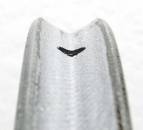
The redesigned rim features a deep center channel to accommodate an inflated tire's basetape. The rounded shoulder are to reduce tubular pinch flats. © Cyclocross Magazine
The 303 Cyclocross wheels are a great candidate for a dual-duty wheelset that could also be used in the “off-season” for road racing and time trials. Zipp’s “Aerodynamic Boundary Layer Control” dimpled surface provides aerodynamic benefits at road speeds. Combined with their impressive weight, you can’t help but be faster.
Although these $2285 wheels cost more than many complete bikes and their cost-to-weight-savings ratio is high, at 1206g, the weight savings and amount of useful technology in this wheelset are impressive. In just a few seasons, the wheelset has racked up plenty of top-level wins here in the States and in Europe under Compton, Todd Wells, the Cannodale/CyclocrossWorld team and one tiny one in NorCal under our own pedaling. It’s important to note, as with many wheels in this review, a good amount of the weight savings come from the hubs, and Zipp’s front hub and rear freehub are some of the lightest in this group. They’re $586 more than the Easton EC90SL for just 24g of weight savings. That’s $20 per gram, 20 times the $1/gram benchmark, a significant price difference and enough to buy a season’s worth of tires.
But it’s the price to pay for world-class weight and some significant benefits: better braking, brake pad flexibility, exposed nipples for easy truing and a freehub that takes a wider variety of cassettes. If we won the lottery, we’d buy a few sets of these for racing and training, and even pay a neutral support vehicle and mechanic to follow behind with our extra sets on training rides should we flat.
For more info: Zipp.com
Photo Gallery:













